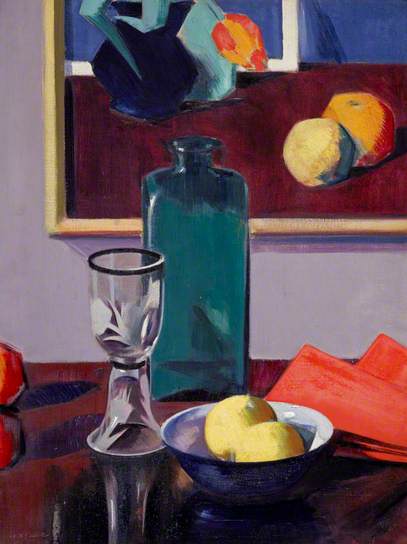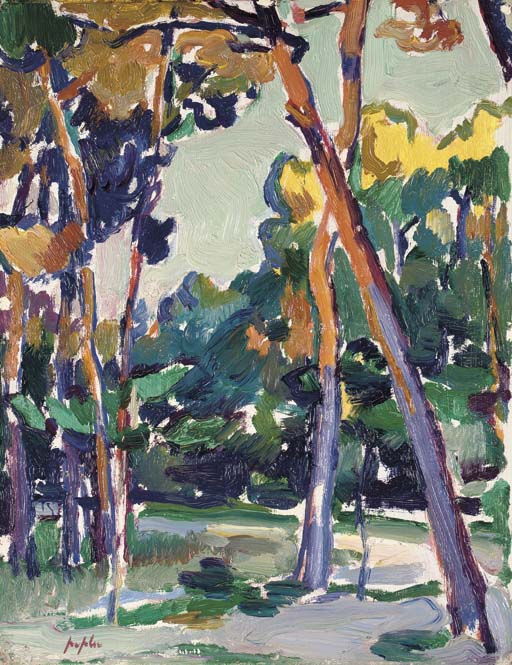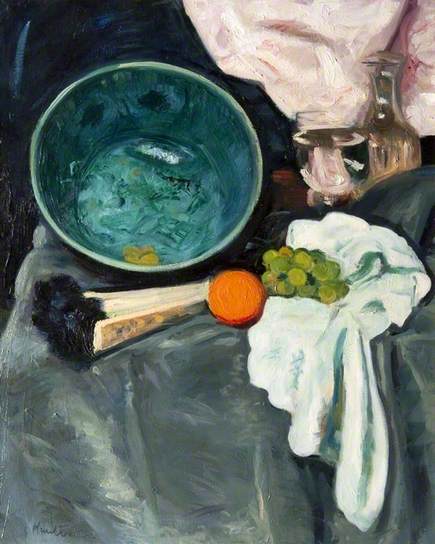Cadell Artist Biography
Francis Cadell was born in Edinburgh on 12 April 1883 at 4 Buckingham Terrace. He was the first born of Francis Cadell, a surgeon, and his wife Mary Hamilton Boileau. Cadell’s youthful aspiration to attend art school was encouraged by his liberal parents. After leaving the Edinburgh Academy at the age of sixteen, he moved with his mother and sister to Paris in 1899. In Paris he enrolled at the Académie Julian, a private studio school popular with expatriate students, at which Peploe had previously studied. Cadell returned to Edinburgh in 1902, where he exhibited at the Royal Scottish Academy and Society of Scottish Artists for the first time.
In 1906 he and his family moved briefly to Munich, where he attended the Akademie der bildenden Künste, arriving back in Edinburgh in 1908. In 1909 Cadell mounted his first solo show at Aitken and Dott (later, The Scottish Gallery) in Edinburgh, which was largely unsuccessful. Cadell, however, benefitted from having been well travelled in his youth and he was able to capitalise on family connections, through which he met many of the future patrons who were able to support him through the financial uncertainties of his career. Among such figures was Sir Patrick Ford, who financed a brief but formative sojourn to Venice in 1910. During his stay in Venice, Cadell’s handling of paint became looser and more expressive and he began to experiment with increasingly vibrant colours.
Upon his establishment as a working artist in Edinburgh, Cadell successfully distinguished himself as a painter of portraits, figure subjects, still lifes and interior scenes, epitomizing the quiet elegance of Edinburgh’s New Town and appealed to its genteel denizens. As his artistic practice was largely confined to Scotland, Cadell was less responsive to continental developments than the other Colourists; instead he closely focused on studio and interior scenes, experimenting formally with colour and composition. Cadell’s relative artistic isolation and his regular painting trips to Iona have encouraged the perception that he is the most ‘Scottish’ of the Colourists.
Within Cadell’s concentrated focus on still lifes and interior scenes, there is a clear development of style in his oeuvre. In his pre-war paintings, Cadell’s paint handling is marked by a feathery ethereal quality. His early interior scenes also tend towards a restricted, harmonious palette of lilac-tinged whites, rich creams and greys. Works such as The Artist’s Drawing Room (1912), painted at Cadell’s studio at 130 George Street, highlight the artist’s interest in the depiction of exquisite objects. The gilded chair, magnificent chandelier and polished grand piano evoke an atmosphere of quiet refinement. Against the restricted lavender and mauves of the backdrop, the crimson throw draped over the chaise longue dominates the canvas, subtly modulating the surrounding objects: crimson tones are projected onto the wall behind the chaise, picked up in the reflective silver candelabra and on the heavily polished black floor. The Artist’s Drawing Room is redolent of Turner’s famous interior studies of Petworth House, which similarly focus on the effects of light in such elegant interiors. Many of Cadell’s earlier interior scenes and figure studies share the soft, restricted palette with the portraiture and nocturnes of Whistler. Cadell’s Girl in Pink and White (c.1911), although painted in a looser more suggestive style, is reminiscent in its tonal range and interest in complementary colours of portraits such as Whistler’s Harmony in Pink and Grey: Lady Meux (1881). Paintings such as Cadell’s Afternoon (c. 1912) share the muted, languorous glamour of Whistler’s studio study (c. 1865) and of the elegant society portraiture of Sir John Lavery and artists such as John Singer Sargent.
By the 1920s the languid colouring and fluid handling of Cadell’s earlier works was displaced by an increasing interest in strident colours, a hardening of line and composition, and a flatter painting style marked by a matte facture. The Scottish National Gallery’s Portrait of a Lady in a Black Hat (date?) marks this stylistic transition, the dominance of black in the canvas flattens the composition and the multiplicity of layered brush-strokes with which Cadell built up his earlier paintings is replaced with barely perceptible strokes, further accentuating the flatness of the works. During the 1920s Cadell’s colours become increasingly strident, climaxing in paintings such as Interior: The Orange Blind (c. 1927) where the aggressive orange blind and teal covered chaise longue are overwhelming in their intensity. The left side of the canvas suggests Cadell’s continuing interest on the effect of light on colour; the orange light filtering through the blind interacts with the blue-black walls in an interesting way – echoing to the way the red throw modulates surrounding colours in the earlier canvas The Artist’s Drawing Room.
In Cadell’s interiors of the 1920s the softness of the pre-war interiors is replaced by a racy Jazz-Age sensibility, the interiors are dominated by a geometric linearity and strong colours compete with an increasing use of flat black. The change in Cadell’s style coincides with his move to a new studio at 6 Ainslie Place, in a Regency town house on the western fringe of Edinburgh’s New Town. Cadell decorated his new premises in a bold colour scheme, influenced by the fashionable Art Deco style.
From about 1912 until at least 1933 Cadell visited the island of Iona virtually every summer, where he produced luminous seascapes and landscapes. Iona had particular attractions for the artist; the ever-changing weather, azure seas and pristine beaches were the perfect subject for the simple lyrical landscapes, which enjoyed commercial success. In 1924, for example, Cadell sold twenty-two Iona pictures and over thirty in 1925 and 1926.

Paintings of Iona by F.C.B. Cadell 1883-1937 and S.J. Peploe 1871-1935 by Philip Coupe
Cadell
Francis Cadell was born in Edinburgh on 12 April 1883 at 4 Buckingham Terrace... Read More
Peploe
Peploe was born at 39 Manor Place, Edinburgh on 27 January 1871, the son of Robert Luff Peploe... Peploe
Hunter
[George] Leslie Hunter was the only one of the Colourists who was not associated with Edinburgh... Read More
